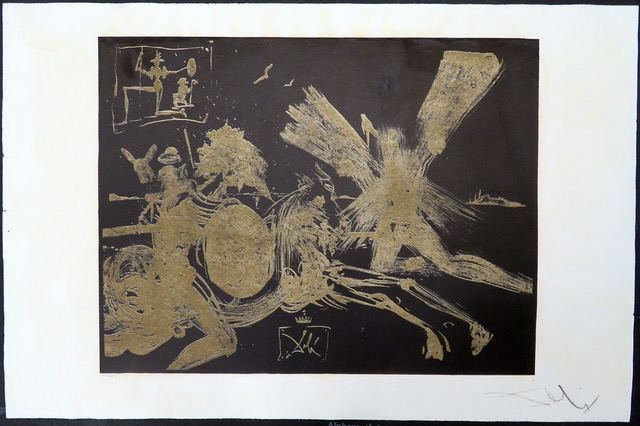Salvador Dali - Face in the Windmill
Salvador Dali
Spanish (1904 – 1989)
Salvador Dali The Face in the Windmill 1965
The Salvador Dali Face in the Windmill was printed in 1965. Sidney Lucas, New York, published the etching in 1965. The total tirage is 162. There are no proofs. There are 2 copies for copyright. This lithograph is on Arches wove paper. Additionally, Salvador Dali signed the etching with 1965 in the lower right. The lithograph is numbered in the lower left. The Sidney Lucas ink stamp is next to the numbering. This is a requirement for this etching. The image size is 19 3/4 x 25″. Also, the sheet is 25 1/8 x 38 1/4″. In the images below we show detail from the etching. These include the watermark, signature with date, and the print club stamp.
We guarantee the Salvador Dali The Face in the Windmill lithograph to be authentic. Read the terms for the guarantee. We provide a Certificate of Authenticity. There is a link on the main Dali page.
This is background information.
Salvador Dalí was born on May 11, 1904, in Figueres, Spain. From an early age, Dalí was encouraged to practice his art. He eventually went on to study at an academy in Madrid. In the 1920s, he went to Paris and began interacting with artists such as Picasso, Magritte and Miró. These interactions led to Dalí’s first Surrealist phase. He is perhaps best known for his 1931 painting The Persistence of Memory. This painting shows the iconic image of melting clocks in a landscape setting. Dali used the melting clocks in several of his later works. The rise of fascist leader Francisco Franco in Spain led to the artist’s expulsion from the Surrealist movement. However, that didn’t stop him from painting. Dalí died in Figueres in 1989. Click on this link for additional background information on Salvador Dali.
The basis of the story
Precipitating from around the 10th century the legend of George slaying the dragon became a story that spread from the eastern regions of the Middle East, through Europe via the Crusades. The dragon represents evil. St. George represents the guardian angel of Aragon. The story is that a monster besieges Selem. To save the town, one of the youngest was sacrificed to the monster. However, when the daughter of the king was to be sacrificed, St. George rides to pacify the dragon. The dragon is then led to the town, and the population converts to Christianity. Eventually, St. George kills the dragon.
For additional background information click on this link for more information.
Call us for more information. The etching is Available!!!
Click on the thumbnail for a larger image.
Go to the main Individual Works Page for complete etching information.



